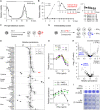Modulating environmental signals to reveal mechanisms and vulnerabilities of cancer persisters
- PMID: 35089788
- PMCID: PMC8797778
- DOI: 10.1126/sciadv.abi7711
Modulating environmental signals to reveal mechanisms and vulnerabilities of cancer persisters
Abstract
Cancer persister cells are able to survive otherwise lethal doses of drugs through nongenetic mechanisms, which can lead to cancer regrowth and drug resistance. The broad spectrum of molecular differences observed between persisters and their treatment-naïve counterparts makes it challenging to identify causal mechanisms underlying persistence. Here, we modulate environmental signals to identify cellular mechanisms that promote the emergence of persisters and to pinpoint actionable vulnerabilities that eliminate them. We found that interferon-γ (IFNγ) can induce a pro-persistence signal that can be specifically eliminated by inhibition of type I protein arginine methyltransferase (PRMT) (PRMTi). Mechanistic investigation revealed that signal transducer and activator of transcription 1 (STAT1) is a key component connecting IFNγ's pro-persistence and PRMTi's antipersistence effects, suggesting a previously unknown application of PRMTi to target persisters in settings with high STAT1 expression. Modulating environmental signals can accelerate the identification of mechanisms that promote and eliminate cancer persistence.
Figures



References
-
- Sharma S. V., Lee D. Y., Li B., Quinlan M. P., Takahashi F., Maheswaran S., McDermott U., Azizian N., Zou L., Fischbach M. A., Wong K.-K., Brandstetter K., Wittner B., Ramaswamy S., Classon M., Settleman J., A chromatin-mediated reversible drug-tolerant state in cancer cell subpopulations. Cell 141, 69–80 (2010). - PMC - PubMed
-
- Ramirez M., Rajaram S., Steininger R. J., Osipchuk D., Roth M. A., Morinishi L. S., Evans L., Ji W., Hsu C.-H., Thurley K., Wei S., Zhou A., Koduru P. R., Posner B. A., Wu L. F., Altschuler S. J., Diverse drug-resistance mechanisms can emerge from drug-tolerant cancer persister cells. Nat. Commun. 7, 10690 (2016). - PMC - PubMed
-
- Hata A. N., Niederst M. J., Archibald H. L., Gomez-Caraballo M., Siddiqui F. M., Mulvey H. E., Maruvka Y. E., Ji F., Bhang H. C., Radhakrishna V. K., Siravegna G., Hu H., Raoof S., Lockerman E., Kalsy A., Lee D., Keating C. L., Ruddy D. A., Damon L. J., Crystal A. S., Costa C., Piotrowska Z., Bardelli A., Iafrate A. J., Sadreyev R. I., Stegmeier F., Getz G., Sequist L. V., Faber A. C., Engelman J. A., Tumor cells can follow distinct evolutionary paths to become resistant to epidermal growth factor receptor inhibition. Nat. Med. 22, 262–269 (2016). - PMC - PubMed
-
- Shen S., Vagner S., Robert C., Persistent cancer cells: The deadly survivors. Cell 183, 860–874 (2020). - PubMed
-
- Russo M., Crisafulli G., Sogari A., Reilly N. M., Arena S., Lamba S., Bartolini A., Amodio V., Magrì A., Novara L., Sarotto I., Nagel Z. D., Piett C. G., Amatu A., Sartore-Bianchi A., Siena S., Bertotti A., Trusolino L., Corigliano M., Gherardi M., Lagomarsino M. C., Nicolantonio F. D., Bardelli A., Adaptive mutability of colorectal cancers in response to targeted therapies. Science 366, 1473–1480 (2019). - PubMed
Publication types
MeSH terms
Substances
Grants and funding
LinkOut - more resources
Full Text Sources
Other Literature Sources
Medical
Research Materials
Miscellaneous

